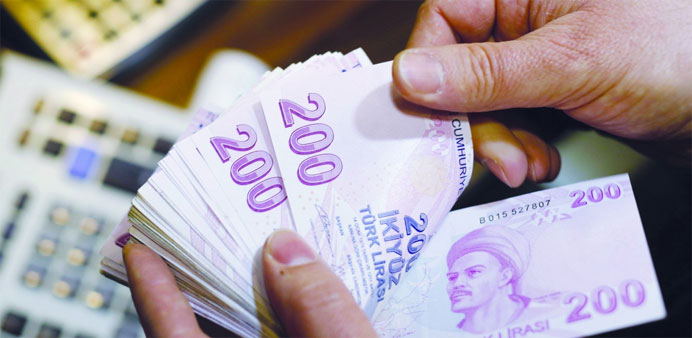The weakened lira is weighing on Turkish businesses, which owed a net $198.3bn of non-lira debt as of February
Bloomberg/Istanbul
The Turkish lira’s post-election rally is over as investors shift their focus from Prime Minister Recep Tayyip Erdogan’s victory last month to companies needing to repay their foreign-currency debts, the top forecaster said.
The currency will slip 1.7% in the second quarter and end the year little changed, according to Przemyslaw Kwiecien, chief economist at X-Trade Brokers Dom Maklerski in Warsaw, the most accurate analyst of the lira in the first three months of 2014. While the lira has risen 3.2% since the March 30 vote, it remains 15% lower over the past 12 months, boosting corporate debt-servicing costs, he said.
The weakened currency is weighing on Turkish businesses, which owed a net $198.3bn of non-lira debt as of February, central bank data show. While political unrest has calmed since a graft probe targeting the government erupted in December, Turkey’s economic growth is still predicted to decelerate to 2.3% this year from 3.9% in 2013, according to economist forecasts surveyed by Bloomberg.
“The economy is going to slow down and those indebted in US dollars will have problems on the revenue side,” Kwiecien said in a phone interview on April 14. “The pressure on the lira may reappear because fears that those dollar debts won’t be repaid will return.”
While Turkey’s per-capita income has more than doubled to $10,782 since Erdogan came to power in 2003, the growth has been increasingly dependent on surging private debt. Corporate and consumer borrowing jumped to 67% of gross domestic product in 2013 from 33% in 2008, before the Federal Reserve began buying debt for its quantitative-easing programme.
Turkish companies’ foreign-exchange borrowings surged from $39.4bn at the end of 2002 to $152bn six years later and $169.6bn at the close of 2012, central bank data show.
The lira has averaged 1.54 per dollar since Erdogan became prime minister, reaching a seven-year high of 1.1491 in January 2008. It touched a record-low of 2.3900 on January 27 this year, prompting the central bank to more than double its benchmark interest rate to 10% after an emergency meeting the following day.
The currency will weaken to 2.24 per dollar in the second quarter and will end the year at 2.25, according to the median of 26 estimates compiled by Bloomberg.
Technical indicators point to further near-term weakness for the lira. The daily moving average convergence-divergence, or MACD, which provides buy and sell signals, is poised to turn more bearish. The currency’s five-week rally stalled near 2.0841, the September 2013 low, from where the lira began its recent decline.
“We have no doubt that some companies will be facing very significant financial distress and some might not be able to roll their obligations, leading to company failures or defaults,” Tevfik Aksoy, chief economist for Europe, Middle East and Africa at Morgan Stanley, wrote in an e-mailed note on April 11. “Many companies borrowed externally to take advantage of the quantitative easing.”
Morgan Stanley predicts the lira will weaken to 2.30 per dollar in 2014. Goldman Sachs Group expects a drop to 2.50 in the next 12 months.
The Fed cut the pace of asset purchases to $55bn a month at its last meeting March 19, its third consecutive reduction, from $85bn in November. The central bank said rates would remain low for a “considerable time” after it ends its bond-buying programme, even as the economy strengthens. US industrial production rose more than forecast in March after a February gain that was twice as big as previously estimated, a report showed on Wednesday.
Turkish inflation accelerated to 8.4% in March, exceeding the 8.1% median estimate in a Bloomberg survey, while producer prices jumped an annual 12.3%, according to data released this month. Unemployment increased to 10.1% in January.
While markets have rallied since Erdogan strengthened his grip on power on March 30, weakness may resurface before voters return to the polls in August to elect a president, according to Lars Christensen, chief emerging-market analyst at Danske Bank in Copenhagen and the third most-accurate lira forecaster.
“I am not overly optimistic on the lira in the medium term,” he said by phone on Wednesday, predicting the currency will weaken to 2.20 in the fourth quarter. “I am a little worried that in the next couple of months, we can see more pressure on the lira. Political tension can heat up again before the presidential election.”



